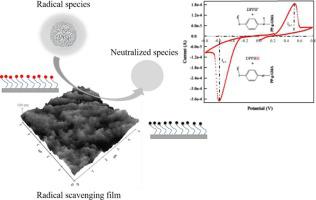当前位置:
X-MOL 学术
›
Prog. Org. Coat.
›
论文详情
Our official English website, www.x-mol.net, welcomes your feedback! (Note: you will need to create a separate account there.)
Photografting of p-anisidine-glycidyl methacrylate onto polymeric substrate for developing free-radical scavenging films
Progress in Organic Coatings ( IF 6.6 ) Pub Date : 2020-12-01 , DOI: 10.1016/j.porgcoat.2020.105925 Kambiz Sadeghi , Jongchul Seo
Progress in Organic Coatings ( IF 6.6 ) Pub Date : 2020-12-01 , DOI: 10.1016/j.porgcoat.2020.105925 Kambiz Sadeghi , Jongchul Seo

|
Abstract In this study, we present a facile approach for the development of a non-migratory antioxidant film via photografting of a conducing polymer (p-anisidine (PA)) onto polypropylene (PP). Initially, the surface of the PP film was functionalized via UV grafting (365 nm) of glycidyl methacrylate (GMA) in the presence of benzophenone (BP) into the methanol or mixed solvents (methanol and water). The addition of 40 v/v% of water into the coating solution led to an increase in grafting density, a reduction in UV-irradiation time, and changes in the grafting morphology. Scanning electron microscopy and atomic force microscopy were used in the identification of the breath figure array structure and brush-like grafting configuration on the surface of the films that were grafted in the mixed solvent (40 v/v % water). Subsequently, PA was immobilized onto the PP-g-GMA films via a ring-opening reaction wherein the PP-g-GMA films developed in the mixed solvent (40 % water) immobilized a higher amount of PA (2.114 ± 0.0013 μM), compared with those developed in methanol (1.760 ± 0.0070 μM). Fourier-transform infrared spectroscopy and solid state 13C nuclear magnetic resonance showed the chemical structure of the grafted surface and identified the grafting mechanism. Moreover, PP-g-GMA-g-PA films presented a strong free-radical scavenging activity using the DPPH assay. Furthermore, cyclic voltammetry analysis exhibited strong oxidation and reduction potential peaks, which proved the antioxidant activity of the films. Therefore, this newly developed free-radical scavenging film can be used as a non-migratory antioxidant film for a variety of applications, such as biomedical, cosmetic, and packaging.
中文翻译:

对茴香胺-甲基丙烯酸缩水甘油酯光接枝到聚合物基材上用于开发自由基清除膜
摘要 在这项研究中,我们提出了一种通过将导电聚合物(对茴香胺(PA))光接枝到聚丙烯(PP)上来开发非迁移性抗氧化膜的简便方法。最初,在二苯甲酮 (BP) 存在下,通过将甲基丙烯酸缩水甘油酯 (GMA) 紫外接枝 (365 nm) 到甲醇或混合溶剂(甲醇和水)中,对 PP 膜的表面进行功能化。在涂层溶液中加入 40 v/v% 的水导致接枝密度增加,紫外线照射时间减少,接枝形态发生变化。扫描电子显微镜和原子力显微镜用于鉴定在混合溶剂(40 v/v %水)中接枝的薄膜表面的呼吸图形阵列结构和刷状接枝构型。随后,PA 通过开环反应固定在 PP-g-GMA 薄膜上,其中在混合溶剂(40% 水)中形成的 PP-g-GMA 薄膜固定了更高量的 PA(2.114 ± 0.0013 μM),与那些在甲醇中开发的 (1.760 ± 0.0070 μM)。傅里叶变换红外光谱和固态 13C 核磁共振显示了接枝表面的化学结构并确定了接枝机制。此外,使用 DPPH 测定,PP-g-GMA-g-PA 薄膜表现出很强的自由基清除活性。此外,循环伏安分析显示出强烈的氧化和还原电位峰,这证明了薄膜的抗氧化活性。因此,这种新开发的自由基清除膜可作为非迁移性抗氧化膜用于多种应用,例如生物医学、
更新日期:2020-12-01
中文翻译:

对茴香胺-甲基丙烯酸缩水甘油酯光接枝到聚合物基材上用于开发自由基清除膜
摘要 在这项研究中,我们提出了一种通过将导电聚合物(对茴香胺(PA))光接枝到聚丙烯(PP)上来开发非迁移性抗氧化膜的简便方法。最初,在二苯甲酮 (BP) 存在下,通过将甲基丙烯酸缩水甘油酯 (GMA) 紫外接枝 (365 nm) 到甲醇或混合溶剂(甲醇和水)中,对 PP 膜的表面进行功能化。在涂层溶液中加入 40 v/v% 的水导致接枝密度增加,紫外线照射时间减少,接枝形态发生变化。扫描电子显微镜和原子力显微镜用于鉴定在混合溶剂(40 v/v %水)中接枝的薄膜表面的呼吸图形阵列结构和刷状接枝构型。随后,PA 通过开环反应固定在 PP-g-GMA 薄膜上,其中在混合溶剂(40% 水)中形成的 PP-g-GMA 薄膜固定了更高量的 PA(2.114 ± 0.0013 μM),与那些在甲醇中开发的 (1.760 ± 0.0070 μM)。傅里叶变换红外光谱和固态 13C 核磁共振显示了接枝表面的化学结构并确定了接枝机制。此外,使用 DPPH 测定,PP-g-GMA-g-PA 薄膜表现出很强的自由基清除活性。此外,循环伏安分析显示出强烈的氧化和还原电位峰,这证明了薄膜的抗氧化活性。因此,这种新开发的自由基清除膜可作为非迁移性抗氧化膜用于多种应用,例如生物医学、



























 京公网安备 11010802027423号
京公网安备 11010802027423号